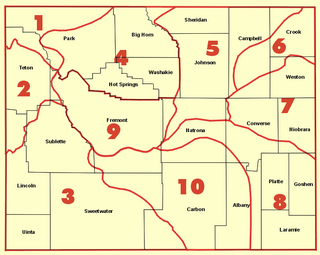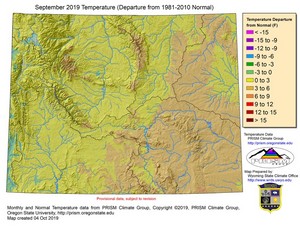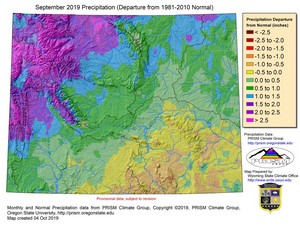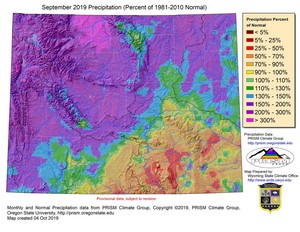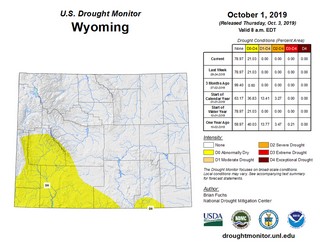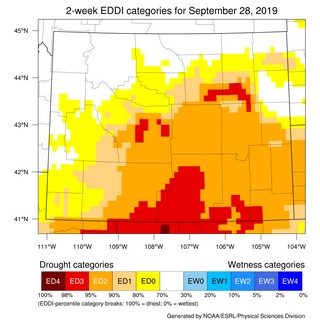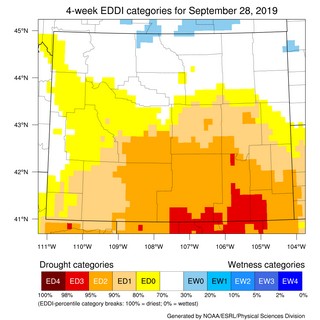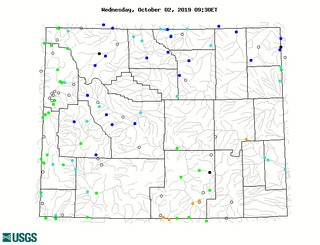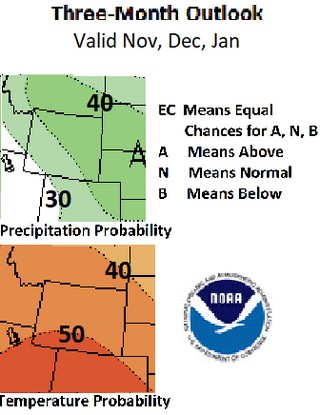 | |
 | |
| WRDS/SCO is currently working remotely so there may be a slight delay returning phone calls. Please email wrds@uwyo.edu if you are in need of information and we will respond as soon as possible |
|
| ||||||||||||
Drought Impacts and Outlook Summaries - 22 October 2019View this Summary as a PDF
Highlights for the State
Drought During the last week of August another area of D0 evolved in southern Albany County. The southwest, however has been the area that has seen the largest expanse of D0 form. Well-below normal precipitation and high evaporative demand through the latter part of August resulted in D0 conditions that now cover almost all of Sublette and Lincoln Counties, all of Uinta County, southwestern Fremont County and Carbon Counties, and all but northeastern Sweetwater County. Recent precipitation in the early part of September will hopefully start to bring some relief to the southwest. Temperatures are still higher than normal and evaporative demand is still above normal so the area will remain in D0 for the near term.
Evaporative Demand The Evaporative Demand Drought Index (EDDI) is showing normal to low-demand conditions across the northeastern half of Wyoming and above-normal demand for the southwestern half. Looking at the two-week index, two areas of concern have developed, one in southern Albany and Carbon Counties and the other in western Sweetwater and eastern Uinta and Lincoln Counties. The northeast has trended more toward normal in the two-week index when compared to the four-week. Additional products can be found at: http://www.wrds.uwyo.edu/sitemap.html Do you have drought impacts to report? We need your on-the-ground reports and you can input them here: http://droughtreporter.unl.edu/submitreport/
Water Resources Reservoir conditions may be viewed online in larger format at: http://www.wrds.uwyo.edu/surface_water/teacups.html Streamflows in Wyoming are at or above normal with the exception of some stations in west central Wyoming and in Carbon and Weston Counties. The map below shows streamflow conditions in Wyoming as of October 02.
Weather and Climate Outlooks Looking at the November through January time period, Wyoming should expect to see above normal precipitation for most of the state with the signal for this being stronger in the northeast. For temperature, above normal conditions are to be expected across all of Wyoming. This pattern is strongest in the southern regions of the state. With warmer than normal temperatures expected, especially in the south, and the chances of above normal precipitation being the weakest there, expect to see drought conditions continue and possibly intensify in the southern third of the state.
You can help us
Heard around the State Natrona Co., Sep 2: "We had green grass into August this year, which is very unusual. Now most of the grass has turned, and the soil is dry. The grasshoppers have eaten a large share of what grew this year." Washakie Co., Sep 8: "Still no significant precipitation. Everything is dry, lawns, fields, forests, gardens, all are in need of irrigation or deep watering! Fire danger is high." Hot Springs Co., Sep 12: "We received 0.96 in rain yesterday. Many of our neighbors have hay down in the field."
Partners
Stay Tuned and In Touch The Wind River Indian Reservation and Surrounding Area Conditions may be found here: https://hprcc.unl.edu/windriver.php |
||||||||||||



